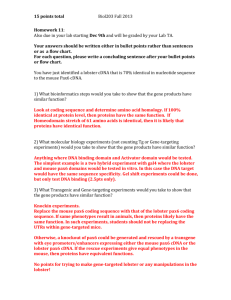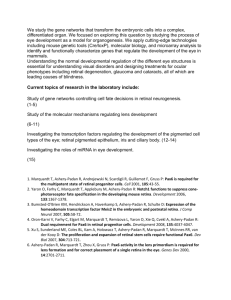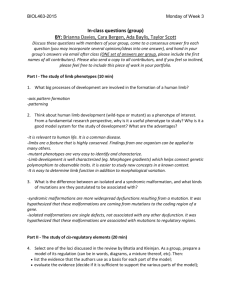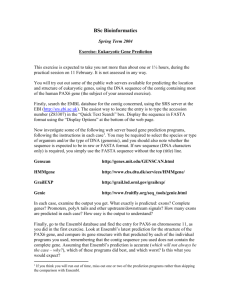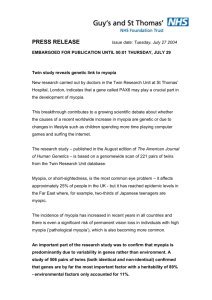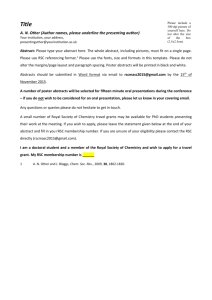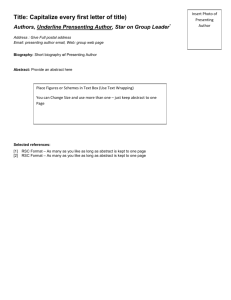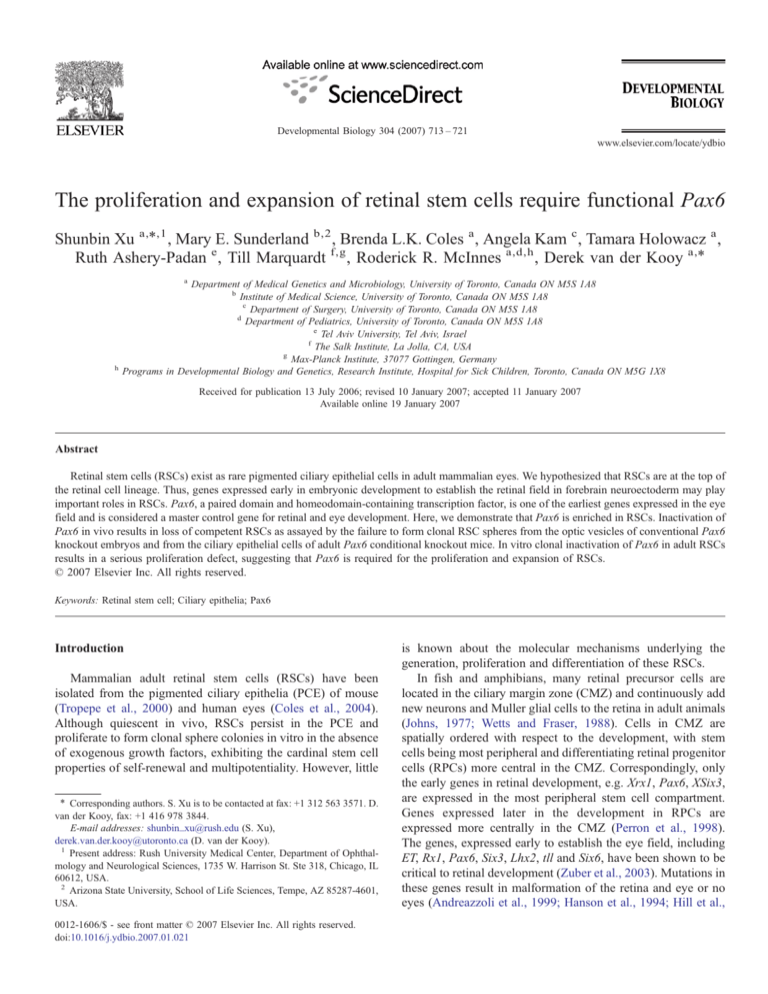
Developmental Biology 304 (2007) 713 – 721
www.elsevier.com/locate/ydbio
The proliferation and expansion of retinal stem cells require functional Pax6
Shunbin Xu a,⁎,1 , Mary E. Sunderland b,2 , Brenda L.K. Coles a , Angela Kam c , Tamara Holowacz a ,
Ruth Ashery-Padan e , Till Marquardt f,g , Roderick R. McInnes a,d,h , Derek van der Kooy a,⁎
a
h
Department of Medical Genetics and Microbiology, University of Toronto, Canada ON M5S 1A8
b
Institute of Medical Science, University of Toronto, Canada ON M5S 1A8
c
Department of Surgery, University of Toronto, Canada ON M5S 1A8
d
Department of Pediatrics, University of Toronto, Canada ON M5S 1A8
e
Tel Aviv University, Tel Aviv, Israel
f
The Salk Institute, La Jolla, CA, USA
g
Max-Planck Institute, 37077 Gottingen, Germany
Programs in Developmental Biology and Genetics, Research Institute, Hospital for Sick Children, Toronto, Canada ON M5G 1X8
Received for publication 13 July 2006; revised 10 January 2007; accepted 11 January 2007
Available online 19 January 2007
Abstract
Retinal stem cells (RSCs) exist as rare pigmented ciliary epithelial cells in adult mammalian eyes. We hypothesized that RSCs are at the top of
the retinal cell lineage. Thus, genes expressed early in embryonic development to establish the retinal field in forebrain neuroectoderm may play
important roles in RSCs. Pax6, a paired domain and homeodomain-containing transcription factor, is one of the earliest genes expressed in the eye
field and is considered a master control gene for retinal and eye development. Here, we demonstrate that Pax6 is enriched in RSCs. Inactivation of
Pax6 in vivo results in loss of competent RSCs as assayed by the failure to form clonal RSC spheres from the optic vesicles of conventional Pax6
knockout embryos and from the ciliary epithelial cells of adult Pax6 conditional knockout mice. In vitro clonal inactivation of Pax6 in adult RSCs
results in a serious proliferation defect, suggesting that Pax6 is required for the proliferation and expansion of RSCs.
© 2007 Elsevier Inc. All rights reserved.
Keywords: Retinal stem cell; Ciliary epithelia; Pax6
Introduction
Mammalian adult retinal stem cells (RSCs) have been
isolated from the pigmented ciliary epithelia (PCE) of mouse
(Tropepe et al., 2000) and human eyes (Coles et al., 2004).
Although quiescent in vivo, RSCs persist in the PCE and
proliferate to form clonal sphere colonies in vitro in the absence
of exogenous growth factors, exhibiting the cardinal stem cell
properties of self-renewal and multipotentiality. However, little
⁎ Corresponding authors. S. Xu is to be contacted at fax: +1 312 563 3571. D.
van der Kooy, fax: +1 416 978 3844.
E-mail addresses: shunbin_xu@rush.edu (S. Xu),
derek.van.der.kooy@utoronto.ca (D. van der Kooy).
1
Present address: Rush University Medical Center, Department of Ophthalmology and Neurological Sciences, 1735 W. Harrison St. Ste 318, Chicago, IL
60612, USA.
2
Arizona State University, School of Life Sciences, Tempe, AZ 85287-4601,
USA.
0012-1606/$ - see front matter © 2007 Elsevier Inc. All rights reserved.
doi:10.1016/j.ydbio.2007.01.021
is known about the molecular mechanisms underlying the
generation, proliferation and differentiation of these RSCs.
In fish and amphibians, many retinal precursor cells are
located in the ciliary margin zone (CMZ) and continuously add
new neurons and Muller glial cells to the retina in adult animals
(Johns, 1977; Wetts and Fraser, 1988). Cells in CMZ are
spatially ordered with respect to the development, with stem
cells being most peripheral and differentiating retinal progenitor
cells (RPCs) more central in the CMZ. Correspondingly, only
the early genes in retinal development, e.g. Xrx1, Pax6, XSix3,
are expressed in the most peripheral stem cell compartment.
Genes expressed later in the development in RPCs are
expressed more centrally in the CMZ (Perron et al., 1998).
The genes, expressed early to establish the eye field, including
ET, Rx1, Pax6, Six3, Lhx2, tll and Six6, have been shown to be
critical to retinal development (Zuber et al., 2003). Mutations in
these genes result in malformation of the retina and eye or no
eyes (Andreazzoli et al., 1999; Hanson et al., 1994; Hill et al.,
714
S. Xu et al. / Developmental Biology 304 (2007) 713–721
1991; Jordan et al., 1992; Lagutin et al., 2003; Mathers et al.,
1997; Porter et al., 1997; Quiring et al., 1994; Yu et al., 2000).
Misexpression of these genes can induce ectopic retinal or eye
tissues (Andreazzoli et al., 1999; Bernier et al., 2000; Chow et
al., 1999; Halder et al., 1995; Loosli et al., 1999; Mathers et al.,
1997; Oliver et al., 1996; Zuber et al., 2003). All of these studies
suggest that the early expressed eye field genes may have
important functions in the regulation of retinal stem cells.
However, the roles of these genes in RSCs have not been fully
studied, especially in mammalian RSCs.
To study the molecular mechanisms underlying the generation, proliferation and differentiation of mammalian RSCs, we
hypothesized that RSCs are at the top of the retinal cell lineage,
and that genes expressed early in embryonic development to
establish the retinal field may play important roles in RSCs.
Pax6, a paired domain and homeodomain containing transcription factor, is one of the earliest genes expressed in the eye field.
It is considered a master control gene for retinal and eye
development (Gehring, 1996; Ton et al., 1991; Walther and
Gruss, 1991). Misexpression of Pax6 induces ectopic eye
structures in Drosophila and Xenopus (Chow et al., 1999;
Halder et al., 1995). Conversely, loss of function of Pax6 results
in aniridia and Peter's anomaly in humans (Hanson et al., 1994;
Jordan et al., 1992), small eye phenotype in mouse (Hill et al.,
1991) and eyeless in Drosophila (Quiring et al., 1994). In Pax6
homozygous mutant mice, retinal development arrests at an
early primitive optic vesicle stage (Grindley et al., 1995; Hill et
al., 1991). Pax6 mutant optic vesicles have reduced proliferation coupled with precocious adoption of a generic neuronal fate
rather than a specific retinal neuron fate (Philips et al., 2005),
suggesting that Pax6 regulates the timing of neurogenesis and
retinal specific neuron differentiation in the developing retina.
In a conditional knockout mouse model, inactivation of Pax6 in
the retina restricted RPC differentiation entirely to amacrine
cells (Marquardt et al., 2001), suggesting that Pax6 is required
for the multipotent state of RPCs. These reports have provided
evidence for the importance of Pax6 in retinal development.
However, the role(s) of Pax6 in RSCs, especially in the adult
RSCs, have not been directly illustrated. We employed both the
conventional and conditional Pax6 knockout mouse models
(Marquardt et al., 2001; St-Onge et al., 1997) to present direct
evidence that Pax6 is required for the proliferation and
expansion of RSCs.
Experimental procedures
RNA preparation and RT-PCR
Total RNA was isolated using RNeasy kit (Qiagen). RT-PCR was performed
using One-Step RT-PCR kit (Qiagen). Primer sequences: Pax6: Fw1:5′TCACAGCGGAGTGAATCAGC-3′ and Rev1:5′-TATCGTTGGTACAGACC
CCCTC-3′; Fw2:5′-CGGAGTGAATCAGCTTGGT-G-3′ and Rev2:5′GTTGGTACAG ACCCCCTCGG-3′. GAPDH: Fw:5′-TGCACCACCAACT
GCTTAGC-3′ and Rev: 5′-TGGATGCAGGGATGATGTTC-3′. 18 s rRNA:
Fw:5′-GTAACCCGTTGAACCCC ATT-3′; Rev: 5′-CCATCCAATCGGTAGTAGCG-3′. Fifty nanograms of total RNA or 1/4 of the RNA from a single
sphere was used in the first round Pax6 amplification with Fw1/Rev1. The
reaction program was 50 °C for 30 min for RT, 95 °C for 15 min to inactivate RT,
followed by 25 cycles of 95°C for 30 s, 60 °C for 1 min and 72 °C for 1 min and
then 72 °C for 10 min. Two microliters of 1:10 dilutant of the first round
amplification product was used in Pax6 nested PCR with primers Fw2/Rev2.
The primers encompass the alternatively spliced exon 5a (Glaser et al., 1992;
Ton et al., 1991; Walther and Gruss, 1991). The amplicons are 367 base pairs
(bp) (without exon 5a) and 409 bp (with exon 5a).
Embryonic day (E)14 and adult RSC primary culture
The dissection and primary culture were performed as described previously
(Tropepe et al., 2000). Briefly, for adult RSC isolation: adult mice were
sacrificed by cervical dislocation. Eyes were removed and placed in oxygenated
artificial cerebral spinal fluid (aCSF: 124 mM NaCl, 5 mM KCl, 1.3 mM MgCl2,
2 mM CaCl2, 26 mM NaHCO3 and 10 mM D-glucose, pH 7.4). Each eye was
bisected and the ciliary body was isolated as a thin strip and placed in dispase
(Invitrogen) for 10 min at 37 °C, followed by trypsin/hyaluronidase treatment
[1.33 mg/mL trypsin (Sigma), 0.67 mg/mL hyaluronidase (Sigma) and 0.2 mg/
mL kynurenic acid (Sigma) in aCSF modified with high Mg2+ (3.2 mM MgCl2)
and low Ca2+ (0.1 mM CaCl2)] at 37 °C for 15 min. Ciliary epithelial cells were
scraped off from the strips and collected in serum free medium (SFM) with
trypsin inhibitor (1 mg/mL; Roche Diagnostics). The cells were triturated 60
times to a single cell suspension. Cells were resuspended in SFM with FGF2
(10 ng/mL) and heparin (2 μg/mL), plated at a low clonal density (10 cells/μL)
and incubated at 37 °C in a CO2 (5%) incubator (Thermo Electron Co.) for
7 days.
For E14 embryos: the eyes were carefully removed and placed in dispase
(Invitrogen) at 37 °C for 30 s. RPE and neural retina (NR) were separated,
collected in SFM and triturated about 60 times to achieve a single cell
suspension. The cells were spun down and resuspended in SFM with FGF2
(10 ng/mL) and heparin (2 μg/mL). The NR cells were plated at 10 cells/μL.
All RPE cells from each animal were plated in 4 wells of a 24-well plate
and the total numbers of RSCs were assessed as the total number of RSC
spheres formed. In Pax6 homozygous knockout (Pax6LacZ/LacZ) embryos,
retinal development was aborted at the primitive optic vesicle stage, which
consisted of a thin epithelial sheet, without the thickening of the inner
neuroretinal layers and the differentiation of the RPE layer. To evaluate the
RSC status in these Pax6LacZ/LacZ embryos, each entire primitive optic
vesicle carefully was dissected, dissociated into single cells and plated in 4
wells of a 24-well plate. Cells were incubated at 37 °C in a CO2 (5%)
incubator for 7 days.
Three and four independent experiments were performed at the adult and
E14 time points, respectively.
Animals
The Z/EG reporter mice (Novak et al., 2000) were provided by Drs. Andras
Nagy and Corrine Lobe. The Pax6LacZ/LacZ (St-Onge et al., 1996, 1997) and αCre;Pax6loxP/loxP mice (Marquardt, 2003; Marquardt et al., 2001) were kindly
provided by Dr. Peter Gruss.
Immunohistochemistry
Pax6, Syntaxin (HPC-1), Rhodopsin (1D4) and nestin antibodies were
purchased from Developmental Hybridoma Bank, Sigma and Chemicon,
respectively. Immunohistochemistry was performed as previously described
(Tropepe et al., 2000).
Fluorescent-activated cell sorting (FACS)
The ciliary epithelial cells of adult Pax6lacZ/wt or wild-type littermates were
isolated and dissociated into single cells in 200 μL of SFM. The cells were
separated into two aliquots; one was treated with 100 μM of a fluorescent β-gal
substrate: 5′-chloromethylfluorescein di-β-D-galactopyranoside (CMFDG)
(Invitrogen), the other was used as negative control. Both aliquots were
incubated at 37 °C for 25′. The cells were spun down and resuspended in
500 μl of SFM + FGF2 (10 ng/ml) + heparin (2 mg/ml). Propidium iodide (PI)
(1.5 μM) was added to assay for live/dead cells. Total live cells were sorted by
the green fluorescence from breakdown product of CMFDG, plated at clonal
density (<10 cells/μl) and incubated at 37 °C for 1 week.
S. Xu et al. / Developmental Biology 304 (2007) 713–721
Retroviral infection
Bi-cistronic pMXIE-Cre-EGFP virus was constructed by inserting a
nlsCre cassette in front of the IRES-EGFP in a replication-incompetent
retroviral construct pMXIE-EGFP (Hitoshi et al., 2002). Ciliary epithelial cells
from adult Pax6flox/flox or Pax6wt/wt animals were isolated and dissociated to
single cells and plated in fibronectin-coated 24-well plates at 10 cells/μl.
Retrovirus (pMXIE-Cre-EGFP or pMXIE-EGFP) was added 18–24 h after
plating (m.o.i = 10). The infected cells (GFP+) were counted under the
fluorescent microscope (Olympus) every 24 h. For differentiation, differentiation
medium (SFM + FGF2 + heparin + 1% fetal bovine serum (FBS)) was added 24 h
after viral infection and was changed every 4 days. After 21 days, cells were fixed
with 4% paraformaldehyde. Immunostaining with the amacrine cell marker,
HPC-1, or the rod photoreceptor marker, 1D4, was performed.
Results
Pax6 is expressed in the adult retinal stem cell niche—the
ciliary epithelia
715
(ESDS) (Tropepe et al., 2000, 2001) and ES cells. The primers
in the RT-PCR assays encompass the alternatively spliced exon
5a (Glaser et al., 1992; Ton et al., 1991; Walther and Gruss,
1991). Although both forms of Pax6 transcripts, with or without
exon 5a (+ 5a or − 5a), were expressed, the ratios of − 5a
transcript to + 5a transcript were different in different tissues
(Fig. 1C). As in the neural retina, the long transcript with exon
5a (+ 5a) was predominant in RSCs and in the ciliary epithelium
(Figs. 1B and C), while the short transcript (− 5a) was
predominant in NSC spheres. The ESDS and undifferentiated
ES cells expressed almost exclusively the short form. The
alternatively spliced exon 5a encodes a 14 amino acid insertion
in the paired domain, which changes the binding specificity of
the paired domain (Epstein et al., 1994a,b; Glaser et al., 1992)
and may contribute to the different functions of Pax6 in
different tissues (Azuma et al., 2005; Dominguez et al., 2004).
Selection for Pax6 enriches for retinal stem cells
To study the role of Pax6 in RSCs, we first asked how Pax6
is expressed in the adult RSC niche—the pigmented ciliary
epithelia. It has been shown that Pax6 is expressed in the ciliary
epithelia and the epithelia of the iris (Marquardt et al., 2001). By
immunohistochemistry and confocal microscopy, Pax6 was
detected in both layers of the ciliary epithelia (Fig. 1A).
However, Pax6 is expressed at a much higher level in the outer
layer (arrows in Fig. 1A), where pigmented RSCs are found
(Tropepe et al., 2000), than in the inner layer (arrowheads in
Fig. 1A). Pax6 expression was further confirmed by RT-PCR
on RNA isolated from ciliary epithelia and clonally derived
RSC spheres from adult mice (Fig. 1B). As controls, Pax6
expression also was assessed and detected in adult neural retina
(NR), forebrain neural stem cell (NSC) spheres (Reynolds and
Weiss, 1996), embryonic stem (ES) cell-derived NSC spheres
To further investigate if Pax6 is expressed in RSCs and its
role as a possible intrinsic regulating factor for RSCs, we
employed the knockout/knockin mouse model (St-Onge et al.,
1997), in which the Pax6 gene, from the start codon through the
entire paired domain, was replaced by β-galactosidase (β-gal)
gene. Therefore, the β-gal expression is under the control of the
endogenous Pax6 promoters and can be used as a marker for
Pax6 expression. In the heterozygous Pax6LacZ/wt ciliary
epithelial cells, the wild-type allele provides the Pax6 function,
while the mutant allele with the β-gal gene provides a marker
for Pax6 expression. Taking advantage of this, the ciliary
epithelial cells from adult Pax6lacZ/wt mice were treated with a
fluorescent β-gal substrate CMFDG and were sorted into three
non-overlapping portions by the intensity of their fluorescence:
Fig. 1. Pax6 is expressed in the adult ciliary epithelia and RSC spheres. (A) Confocal image of Pax6 immunostaining of a ciliary process; Anti-Pax6 monoclonal
antibody stains the nuclei of the positive cells. White arrowheads show the less intensely stained the ciliary epithelial cells of the inner layer; black arrows indicate the
more intensely stained ciliary epithelial cells in the outer layer. The arrowheads and arrows mark the epithelial cells on one side of the ciliary process. (B) RT-PCR of
Pax6 gene expression. Pax6 is detected in clonally derived RSC spheres (RSC) and ciliary epithelia (CE) of adult mice. N ctl: negative control (amplification without
reverse transcription). Amplicons encompass the alternatively spliced exon 5a (Ton et al., 1991; Walther and Gruss, 1991). The amplification products with or without
alternatively spliced exon 5a were labeled as +5a and − 5a. (C). The ratio of the +5a and − 5a transcripts normalized by the control housekeeping gene GAPDH.
716
S. Xu et al. / Developmental Biology 304 (2007) 713–721
Fig. 2. Pax6 is enriched in retinal stem cells and required for the generation of clonal RSC spheres. (A, top) Profiles of the non-treated wild-type and CMFDG-treated
adult Pax6lacZ/wt cells sorted by propidium iodide (PI) and forward scattered count (FSC). The rectangles show the live single cells. The numbers in the rectangles are
percentages of live cells. (Bottom) Profiles of the live single cells sorted by the CMFDG reaction elicited fluorescence. R1, R2 and R3 indicate the three nonoverlapping portions we collected for the clonal RSC sphere assay in Table 1. (B) Examples of the cells from R1, R2 and R3 portions under light microscopy (top) and
fluorescent microscopy (bottom). Note that only cells from R3 portion have significant fluorescence elicited from CMFDG/β-galactosidase reaction; the dashed circle
in the R2 bottom panel marks the R2 cell with very weak fluorescence; (C) clonal RSC sphere assays on adult Pax6lacZ/wt (het) and wild-type (wt) mice; (D) clonal
RSC sphere assays on embryonic day 14 (E14) Pax6LacZ mice. ko: Pax6LacZ/LacZ (n = 9). het: Pax6LacZ/wt (n = 16). wt: wild-type littermates (n = 13).
R1, R2 and R3 (Figs. 2A and B). Subsequent clonal RSC
sphere assays showed that cells with low or no Pax6 expression
(R1 and R2) did not give rise to any RSC spheres (Figs. 2A and
B and Table 1). Only the cells with high Pax6 expression (R3)
gave rise to clonal RSC spheres at a frequency of 1/76, at least a
6.6-fold enrichment of RSCs, compared to the 1/500 frequency
seen in non-sorted ciliary epithelial cells (Tropepe et al., 2000).
This result suggests that high levels of Pax6 expression are
seen in RSCs and that selection for Pax6 enriches for RSCs.
The power of enrichment of RSCs by high levels of Pax6
expression might be underestimated here because the heteroTable 1
Summary of the clonal RSC sphere assays after the FACS sorting
Cells Collected
Spheres Formed
Frequency
R1
R2
R3
5089
0
0
15,396
0
0
832
11
1/76
zygous Pax6LacZ/wt cells used in this experiment have only one
functional Pax6 allele. We have observed a 56% reduction of
sphere formation in the adult Pax6LacZ/wt ciliary epithelial cells
(Fig. 2C) and a similar reduction in E14 embryonic heterozygous RSCs (Fig. 2D) compared to the wild type. Therefore,
we predict a higher RSC enrichment in the wild-type cells
based on their Pax6 expression.
Inactivation of Pax6 function in vivo results in loss of
competent retinal stem cells at embryonic day 14 (E14)
To study the role of Pax6 in the early development of
RSCs, we performed clonal RSC sphere assays on embryonic
day (E) 14 Pax6LacZ mice (Fig. 2D). At this stage in wild-type
mice, RSCs reside in the peripheral retinal pigmented
epithelium (RPE), which includes the presumptive pigmented
ciliary epithelia where the adult RSCs reside (Tropepe et al.,
2000). In Pax6LacZ/LacZ embryos, retinal development arrests
at the early optic vesicle stage (Grindley et al., 1995; Hill et
S. Xu et al. / Developmental Biology 304 (2007) 713–721
717
al., 1991). To evaluate the total RSC population of these
embryos, we harvested the entire rudimentary optic vesicles
from Pax6LacZ/LacZ embryos and performed clonal RSC sphere
assays. No RSC spheres were derived from Pax6LacZ/LacZ
optic vesicle cells. In Pax6LacZ/wt heterozygote, we found a
58% reduction in the number of RSC spheres compared to the
wild type. These results strongly suggest that loss of Pax6
function led to a complete loss of competent RSCs in Pax6
knockout embryos and that a decreased level of Pax6 in the
heterozygote resulted in a reduction in RSC population. Thus,
Pax6 is required for the generation of clonal RSC spheres.
The RSC spheres are composed by a few stem cells, but the
majority of the cells in the spheres are progenitor cells. The
failure to form RSC spheres could be a result of defects in
either the stem cells or the progenitor cells or both. At E14,
the neural retina contains RPCs, which can proliferate and
form primary PRC spheres, which, however, cannot be
clonally passaged because of their limited self-renewal ability
(Tropepe et al., 2000). A clonal RPC sphere assay on the
heterozygote and wild-type controls showed a slight but not
significant decrease in the numbers of RPC from the
heterozygote when compared to the wild type [3.6 ± 0.7
(n = 12) in the heterozygote versus 4.9 ± 1.0 (n = 9) per 5000
cells in the wild type, p = 0.27 (Kruskal–Wallis test)]. This
suggests that the effect of inactivation of Pax6 on clonal RSC
sphere formation cannot be explained fully by its effect on
RPCs and that inactivation of Pax6 may have a direct effect
on the proliferation of RSCs.
Pax6 is required for RSC sphere formation in adult animals
LacZ/LacZ
The Pax6
conventional knockout mice die soon after
birth. Therefore, to directly study the role of Pax6 in RSCs in
adult mice, we employed the α-Cre;Pax6loxP/loxP conditional
knockout mouse model (Marquardt et al., 2001), in which the
endogenous Pax6 gene was replaced by a modified Pax6 allele,
Pax6loxP, in which exons 4–6 are flanked by two loxP sites. The
expression of Cre recombinase is under the control of the Pax6
retinal specific regulatory element, α promoter (Kammandel et
al., 1999), which targets the expression of Pax6 to the peripheral
neuroretina, ciliary epithelia and the iris. A RSC sphere assay on
the adult conditional knockout mice (Fig. 3A) revealed that there
were 23% (p < 0.05) and 72% (p < 0.05) decreases in the
numbers of clonal RSC spheres derived from the heterozygote
and conditional knockout, respectively, compared to wild type.
This suggests that inactivation of Pax6 results in a negative
effect on the competence of RSCs to form RSC spheres and
possibly the maintenance of RSCs in adult animals.
It has been shown that the α-promoter activity has a dorsal
expressional gap at E13.5 (Kammandel et al., 1999; Marquardt
et al., 2001). If this expression gap persists in the adult mice, Cre
recombinase in the α-Cre transgenic animals would fail to be
expressed in the gap region, and hence, Pax6 function would
not be inactivated in the gap. Therefore, we hypothesized that
the spheres from the α-Cre;Pax6loxP/loxP mice might have been
derived from the RSCs that escaped Cre excision. To confirm
the α-promoter controlled expression in adult mice, we
Fig. 3. Pax6 is required for RSC sphere formation in adult animals. (A) RSC
sphere assays in the Pax6 conditional knockout mouse model (Marquardt et al.,
2001). ko: α-Cre+/−; Pax6loxP/loxP (n = 4). het: α-Cre+/−; Pax6loxP/wt (n = 4). wt:
α-Cre−/−; Pax6wt/wt (n = 4). (B) Whole mount fluorescent images of adult α-Cre,
Z/EG mouse eyes showing the α-promoter-driven expression has gaps (marked
by white brackets) as seen from dorsal (left) and ventral (right) views of the
retina. Anterior is on the left. (C) RT-PCR of Pax6 on the clonal RSC spheres
derived from adult α-Cre;Pax6loxP/loxP ciliary epithelial cells. The same primers,
encompassing the alternatively spliced exon 5a, were used. 1: wild-type single
RSC sphere; 2–6: RSC spheres derived from α-Cre;Pax6loxP/loxP CE cells, 7:
negative control (amplification without reverse transcription).
generated α-Cre;Z/EG double transgenic mice. The Z/EG line
(Novak et al., 2000) is a Cre reporter line: Cre excision removes
the lacZ gene and activates the expression of the second
reporter, enhanced green fluorescent protein (EGFP). The αCre;Z/EG double transgenic mice showed that the α promoter
not only has the dorsal expression gap, but also a ventral gap in
the adult mice that extended into the adult peripheral retina and
ciliary epithelia (Fig. 3B). To further confirm our hypothesis
that the residual spheres from the α-Cre;Pax6loxP/loxP mice were
derived from the RSCs that have escaped Cre excision, we
performed RT-PCR on the RNA samples from these spheres.
Indeed, all of the spheres derived from the α-Cre;Pax6loxP/loxP
mice were actually Pax6 positive (Fig. 3C). Therefore, no RSC
spheres were derived from true Pax6 knockout ciliary epithelial
cells in adult mice, suggesting that Pax6 is required for clonal
RSC sphere formation.
718
S. Xu et al. / Developmental Biology 304 (2007) 713–721
Inactivation of Pax6 inhibits the proliferation of retinal stem
cells
To study the mechanism(s) of Pax6 on the maintenance of
RSCs, we infected Pax6loxP/loxP and wild-type adult ciliary
epithelial cells in vitro with a bi-cistronic Cre-EGFP retrovirus
(pMXIE-Cre-EGFP) (Fig. 4A), which expresses both Cre
recombinase and EGFP in the infected cells. Since only RSCs
in the adult ciliary epithelial cells divide and only the dividing
cells can be infected with retrovirus, we could use EGFP
expression to trace the infected clonal RSCs in which Pax6
function is inactivated by the Cre recombinase. Four days after
viral infection, the infected cells still retained a retinal precursor
phenotype (Fig. 4B). However, the average number of progeny
in each GFP positive RSC clone derived from a single RSC was
reduced by 65% in Cre-infected Pax6loxP/loxP clones compared
to the Cre-infected wild-type (Pax6wt/wt) RSC clones (Fig. 4C).
Ninety-one percent of the Cre virus-infected Pax6loxP/loxP RSC
clones had only one or two cells/clone (Fig. 4D). Only one of
these Pax6−/− clones had 4 GFP-positive cells, and none of the
clones contained more than 4 GFP positive cells. In contrast,
43% of the wild-type infected clones had more than 4 progeny,
including 2 clones (∼ 7.6%) with 10 or more GFP positive cells.
We did not observe decreases in RSC clone size when using the
control retrovirus (pMXIE-EGFP) in Pax6loxP/loxP or Pax6wt/wt
RSCs (4.8 ± 0.6 and 4.1 ± 0.5 cells/clone, respectively). The CreEGFP virus-infected RSCs survived as well as the control virus
(pMXIE-EGFP)-infected cells. Indeed, we observed more
clones in the pMXIE-Cre-GFP-infected Pax6loxP/loxP cells
than in the wild-type cells (total numbers of clones observed:
in wild-type cells: n = 35 with the Cre-EGFP virus and n = 65
with the EGFP virus; in Pax6loxP/loxP cells: n = 55 with the CreEGFP virus and n = 26 with the EGFP virus). Therefore, the
smaller number of cells per clone in pMXIE-Cre-EGFP-
Fig. 4. Inactivation of Pax6 inhibits the proliferation of RSCs in vitro. (A) pMXIE-Cre-EGFP (top) and pMXIE-EGFP (bottom) retroviral constructs. PCMV: CMV
promoter; nlsCre: Cre recombinase with a nuclear localization signal (nls); EGFP: enhanced green fluorescent protein; IRES: internal ribosomal entry site; pA:
polyA signal. (B) Cre-EGFP retroviral infection of adult Pax6loxP/loxP and wild-type RSCs. (a–h) Pax6 is inactivated in the Cre-EGFP-infected Pax6loxP/loxP RSCs
(arrows in panels a–d), but not the wild-type RSCs (arrowheads in panels e–h). (a, e) GFP channel showing the infected cells; (b, f) Pax6 immunostaining; (c, g)
Hoechst nuclear staining; (d, h) merged images; (i–p) RSCs infected with Cre-EGFP retrovirus retain progenitor identity with neural progenitor marker nestin
expression; (i, m) GFP channel showing the infected cells; (j, n) immunostaining of nestin; (k, o) Hoechst nuclear staining; (l, p) merged images. GFP expression
marks the infected RSCs and their progeny. (C) Average number of progeny in each clone derived from single viral-infected adult RSCs 4 days after retroviral
infection in vitro. Data represent means ± SEMs. (D) Distribution of different sized clones derived from single virus-infected RSCs 4 days after Cre-EGFP retroviral
infection of wild-type or Pax6loxP/loxP ciliary epithelial cells. (E) Immunohistochemistry of differentiated RSCs from Pax6loxP/loxP animals 21 days after pMXIECre-EGFP viral infection with syntaxin monoclonal antibody. Arrowheads showed two infected cells, which are expressing the amacrine cell marker syntaxin.
Arrows pointed two non-infected cells, which were syntaxin negative.
S. Xu et al. / Developmental Biology 304 (2007) 713–721
Table 2
Differentiation assays on the pMXIE-Cre-EGFP retroviral-infected RSCs
Cell type
Pax6Flox/flox
Pax6wt/wt
Amacrine cells (syntaxin positive)
Rod photoreceptors (1D4 positive)
97.2 ± 2.8
0.95 ± 0.9
12.8 ± 1.1
21.8 ± 1.7
infected Pax6 mutant RSCs cannot be due to more cell death of
RSCs. The best explanation for this result is that inactivation of
Pax6 inhibits the proliferation of RSCs.
Previously, Marquardt et al. (2001) showed that Pax6
inactivation results in the exclusive generation of amacrine
cells in the retina. To determine the function of Pax6 on fate
determination in adult RSCs and their progeny, we differentiated retrovirus-infected RSC colonies on laminin coated
slides. The results showed that inactivation of Pax6 by retroviral
expression of Cre-EGFP in Pax6loxP/loxP RSCs resulted in
differentiation almost exclusively into amacrine cells using
syntaxin as a marker (97.2 ± 2.8% versus 12.8 ± 1.1% in wildtype infected RSC colonies) (Table 2 and Fig. 4E), consistent
with the previous observation by Marquardt et al. (2001) in αCre;Pax6loxP/loxP animals in vivo. In contrast, only 0.95 ± 0.9%
of infected cells are rhodopsin (1D4) positive photoreceptors
amongst the Pax6loxP/loxP cells compared to 21.8% + − 1.7% in
wild-type infected RSC colonies. Our data suggest that
inactivation of Pax6 produces two effects: inhibiting the
proliferation of RSCs, and separately, directing the differentiation of RSC progeny to an amacrine cell fate.
Discussion
Mammalian adult RSCs exist as rare pigmented ciliary
epithelial cells. They are quiescent in vivo, but they persist
through their adult lives, maintaining their capability to selfrenew and differentiate into mature retinal cell types (Coles et
al., 2004; Tropepe et al., 2000). Previously, we demonstrated
that the numbers of retinal progenitors negatively regulate the
numbers of RSCs by a cell non-autonomous mechanism in vivo
(Coles et al., 2006; Tropepe et al., 2000). Here, we reveal
directly that Pax6 is required for the proliferation and thus the
expansion of RSCs. In vivo, this serious proliferation defect in
Pax6−/− RSCs would preclude the expansion of the first RSCs
by symmetrical divisions in the embryonic optic cup, as well as
inhibit the expansion of the retinal progenitor populations
through asymmetric proliferation of RSCs.
Our result showed that Pax6 is highly expressed in the
retinal stem cell niche—the pigmented ciliary epithelia.
Previously, Pax6 has been shown to be expressed in the ciliary
epithelia (Das et al., 2005; Marquardt et al., 2001). By
immunostaining and confocal microscopy, the present report
reveals that Pax6 expression is not equal in the two layers of the
ciliary epithelia (Fig. 1). Pax6 is expressed at a much higher
level in the outer layer than the inner layer of the ciliary
epithelia. The inner layer of the ciliary epithelia is nonpigmented and is continuous with the neural retina, the outer
layer is pigmented and continuous with the RPE. It is the outer
pigmented layer where the RSCs reside (Tropepe et al., 2000).
719
Therefore, the results suggest that high level Pax6 expression
co-exists with RSCs in the outer pigmented ciliary epithelia.
Our FACS sorting and subsequent clonal sphere assay further
showed that only the cells with the highest levels of Pax6
expression can give rise to RSC spheres, suggesting that Pax6 is
highly enriched in RSCs and that high levels of Pax6 expression
are hallmarks of the retinal stem cells.
Clonal RSC sphere assays on both the embryonic retina of
the conventional knockout mice and adult retina of the
conditional knockout mice revealed that Pax6 expression is
not only a hallmark of the retinal stem cells, but also that Pax6
is required for their stemness or competence to form RSC
spheres (Figs. 2D and 3A). In Pax6 homozygous knockout
(Pax6LacZ/LacZ ) embryos, retinal development is arrested at a
primitive optic vesicle stage. Although some RPE markers are
expressed in these primitive optic vesicles, no fully differentiated RPE is developed in the Pax6 knockout embryo
(Grindley et al., 1995; Baumer et al., 2003; Philips et al., 2005).
However, the mere absence of the pigment could not be the
reason for the loss of RSC competence. Previously, we have
shown that similar numbers of RSC spheres can be derived from
pigmented and non-pigmented animals (Tropepe et al., 2000).
Furthermore, the experiments employing in vitro inactivation of Pax6 by the Cre-EGFP retroviral infection showed that
the underlying mechanism is a requirement for Pax6 in the
proliferation and expansion of retinal stem cells (Fig. 4). Our in
vitro inactivation of Pax6 experiment supports that the inability
of adult retinal stem cells to form spheres is the result of a
decrease in their ability to proliferate. Previously, Marquardt et
al. (2001) showed a reduced proliferation of RPCs in the Pax6
conditional knockout retina at E12.5–18.5. While we were
preparing this manuscript, Philips et al. (2005) also reported
reduced proliferation of RPCs in Pax6−/− optic vesicle at E10.5.
We believe that Pax6 plays roles in both the proliferation and
differentiation of RSCs and RPCs. Our present study is the first
report on the function of Pax6 in retinal stem cells and our
results uncovered a novel aspect of Pax6 function that it plays
important roles in the proliferation of retinal stem cells, other
than in the retinal progenitor cells.
Our finding that Pax6 is required for the expansion of RSCs
contrasts with the function of Pax6 in the cortical neural stem
cells, where inactivation of Pax6 results in increased proliferation of neural stem cells and overexpression of Pax6 in cortical
precursors led to decreased proliferation (Estivill-Torrus et al.,
2002; Haubst et al., 2004; Heins et al., 2002). However, in
neural progenitor cells, Pax6 appeared to have similar functions
as in retinal progenitors (Philips et al., 2005) to promotes
proliferation by preventing the progenitor cells from exiting the
cell cycles and premature differentiation (Quinn et al., 2006).
Pax6 carries multiple functional domains. It is suggested that
the selective use of the paired domain (PD and PD5a) and
homeodomain of the gene may contribute to the region-specific
differences of Pax6 function (Dominguez et al., 2004; Haubst et
al., 2004; Heins et al., 2002). It appears that both the paired
domain and the homeodomain are important for the regulation
of proliferation and cell fate determination in the retina (Favor et
al., 2001; Haubst et al., 2004), while the homeodomain plays no
720
S. Xu et al. / Developmental Biology 304 (2007) 713–721
role in these functions in the telencephalon (Haubst et al., 2004).
The two different isoforms of paired domains, PD and PD5a,
also impose different effects to the overall function of Pax6 in
different tissues. With the insertion of exon 5a, PD5a appears to
enhance the proliferation rather than the cell fate specification in
both the telencephalon in mouse (Haubst et al., 2004) and the
eyes in vertebrates (Azuma et al., 2005; Singh et al., 2002) and
in Drosophila (Dominguez et al., 2004). The relative predominant expression of the + 5a transcript encoding PD5a in the
RSCs and retina (Fig. 1) may, to some extent, explain the
proliferative deficits we observed in the RSCs in the mouse
models, because both isoforms (PD and PD5a) of the Pax6 are
inactivated in these mouse models (Marquardt et al., 2001; StOnge et al., 1997). The cross-interactions between PD/PD5a
(Epstein et al., 1994a,b), homeodomain (Mishra et al., 2002;
Singh et al., 2000) and the C terminus of Pax6 protein (Singh et
al., 2001, 2002) modulate the overall functions of Pax6 in
different tissue at different developmental stages. More detailed
studies on these cross-interactions and the target genes of Pax6
and Pax6(+ 5a) will be critical to the full understanding of the
different functions of Pax6 in the regulation of the proliferation
and cell fate determination in different tissues.
In our in vitro inactivation experiment, under stem cell
culture condition (non-differentiating), the RSCs with Pax6
inactivated by the Cre recombinase retain retinal precursor
phenotype and continue to express nestin. Under differentiating
condition for 21 days, however, they differentiated almost
exclusively to an amacrine cell phenotype characterized by the
expression of amacrine cell specific marker, syntaxin, consistent
with the observation by Marquardt et al. (2001) in the
conditional knockout retina that inactivation of Pax6 result in
loss of the multipotency of the RPCs in the developing neural
retina, biasing the differentiation of RPCs almost exclusively to
amacrine cells.
In Sey/Sey (Pax6−/− ) embryos, most of the eye field
transcription factors, e.g. Rx1, Six3, Six6 and Lhx2, are
expressed in the rudimentary optic vesicle (Jean et al., 1999;
Mathers et al., 1997; Oliver et al., 1995; Porter et al., 1997).
Other reports show that retinal markers, such as Tyrp2, Mitf and
CHX10 are expressed (Baumer et al., 2003; Grindley et al.,
1995) in Pax6 mutants, arguing that RSCs and progenitor cells
can be formed in the absence of Pax6. The present data suggest
that even if the first RSCs are generated in the embryonic optic
vesicle, the presence of a serious proliferation deficit in Pax6−/−
RSC will limit the expansion of the RSC pool by decreasing
symmetrical divisions and limit the increase of the RPC pool by
decreasing the asymmetrical division of RSCs.
The present study reveals that an intrinsic factor, Pax6, is
required for and acts cell autonomously in retinal stem cells.
Other early genes involved in eye field specification, e.g. ET,
Rx1, Six6 Six3, Lhx2 and tll (Hollemann et al., 1998; Jean et al.,
1999; Li et al., 1997; Mathers et al., 1997; Oliver et al., 1995;
Porter et al., 1997; Zuber et al., 2003) also may play important
roles in retinal stem cells. It will be important to study the
different roles and interactions of these early genes in the
generation, proliferation and differentiation of RSCs. Furthermore, searching for the upstream and downstream targets of
these key players regulating RSCs will open new directions in
the improved manipulation of these stem cells and their use in
the treatment of retinal degeneration.
Acknowledgments
This work was supported by grants from NIH, the Canadian
Institute of Health Research, the Canadian Genetic Diseases
Network and the Stem Cell Network of Canada.
References
Andreazzoli, M., Gestri, G., Angeloni, D., Menna, E., Barsacchi, G., 1999. Role
of Xrx1 in Xenopus eye and anterior brain development. Development 126,
2451–2460.
Azuma, N., Tadokoro, K., Asaka, A., Yamada, M., Yamaguchi, Y., Handa, H.,
Matsushima, S., Watanabe, T., Kohsaka, S., Kida, Y., Shiraishi, T., Ogura,
T., Shimamura, K., Nakafuku, M., 2005. The Pax6 isoform bearing an
alternative spliced exon promotes the development of the neural retinal
structure. Hum. Mol. Genet. 14, 735–745.
Baumer, N., Marquardt, T., Stoykova, A., Spieler, D., Treichel, D., AsheryPadan, R., Gruss, P., 2003. Retinal pigmented epithelium determination
requires the redundant activities of Pax2 and Pax6. Development 130,
2903–2915.
Bernier, G., Panitz, F., Zhou, X., Hollemann, T., Gruss, P., Pieler, T., 2000.
Expanded retina territory by midbrain transformation upon overexpression
of Six6 (Optx2) in Xenopus embryos. Mech. Dev. 93, 59–69.
Chow, R.L., Altmann, C.R., Lang, R.A., Hemmati-Brivanlou, A., 1999. Pax6
induces ectopic eyes in a vertebrate. Development 126, 4213–4222.
Coles, B.L., Angenieux, B., Inoue, T., Del Rio-Tsonis, K., Spence, J.R.,
McInnes, R.R., Arsenijevic, Y., van der Kooy, D., 2004. Facile isolation
and the characterization of human retinal stem cells. Proc. Natl. Acad. Sci.
U. S. A. 101, 15772–15777.
Coles, B.L., Horsford, D.J., McInnes, R.R., van der Kooy, D., 2006. Loss of
retinal progenitor cells leads to an increase in the retinal stem cell population
in vivo. Eur. J. Neurosci. 23, 75–82.
Das, A.V., James, J., Rahnenfuhrer, J., Thoreson, W.B., Bhattacharya, S., Zhao,
X., Ahmad, I., 2005. Retinal properties and potential of the adult mammalian
ciliary epithelium stem cells. Vis. Res. 45, 1653–1666.
Dominguez, M., Ferres-Marco, D., Gutierrez-Avino, F.J., Speicher, S.A.,
Beneyto, M., 2004. Growth and specification of the eye are controlled
independently by Eyegone and Eyeless in Drosophila melanogaster. Nat.
Genet. 36, 31–39.
Epstein, J., Cai, J., Glaser, T., Jepeal, L., Maas, R., 1994a. Identification of a Pax
paired domain recognition sequence and evidence for DNA-dependent
conformational changes. J. Biol. Chem. 269, 8355–8361.
Epstein, J.A., Glaser, T., Cai, J., Jepeal, L., Walton, D.S., Maas, R.L., 1994b. Two
independent and interactive DNA-binding subdomains of the Pax6 paired
domain are regulated by alternative splicing. Genes Dev. 8, 2022–2034.
Estivill-Torrus, G., Pearson, H., van Heyningen, V., Price, D.J., Rashbass, P.,
2002. Pax6 is required to regulate the cell cycle and the rate of progression
from symmetrical to asymmetrical division in mammalian cortical
progenitors. Development 129, 455–466.
Favor, J., Peters, H., Hermann, T., Schmahl, W., Chatterjee, B., NeuhauserKlaus, A., Sandulache, R., 2001. Molecular characterization of Pax6(2Neu)
through Pax6(10Neu): an extension of the Pax6 allelic series and the
identification of two possible hypomorph alleles in the mouse Mus
musculus. Genetics 159, 1689–1700.
Gehring, W.J., 1996. The master control gene for morphogenesis and evolution
of the eye. Genes Cells 1, 11–15.
Glaser, T., Walton, D.S., Maas, R.L., 1992. Genomic structure, evolutionary
conservation and aniridia mutations in the human PAX6 gene. Nat. Genet. 2,
232–239.
Grindley, J.C., Davidson, D.R., Hill, R.E., 1995. The role of Pax-6 in eye and
nasal development. Development 121, 1433–1442.
S. Xu et al. / Developmental Biology 304 (2007) 713–721
Halder, G., Callaerts, P., Gehring, W.J., 1995. Induction of ectopic eyes by
targeted expression of the eyeless gene in Drosophila. Science 267,
1788–1792.
Hanson, I.M., Fletcher, J.M., Jordan, T., Brown, A., Taylor, D., Adams, R.J.,
Punnett, H.H., van Heyningen, V., 1994. Mutations at the PAX6 locus are
found in heterogeneous anterior segment malformations including Peters'
anomaly. Nat. Genet. 6, 168–173.
Haubst, N., Berger, J., Radjendirane, V., Graw, J., Favor, J., Saunders, G.F.,
Stoykova, A., Gotz, M., 2004. Molecular dissection of Pax6 function: the
specific roles of the paired domain and homeodomain in brain development.
Development 131, 6131–6140.
Heins, N., Malatesta, P., Cecconi, F., Nakafuku, M., Tucker, K.L., Hack, M.A.,
Chapouton, P., Barde, Y.A., Gotz, M., 2002. Glial cells generate neurons: the
role of the transcription factor Pax6. Nat. Neurosci. 5, 308–315.
Hill, R.E., Favor, J., Hogan, B.L., Ton, C.C., Saunders, G.F., Hanson, I.M.,
Prosser, J., Jordan, T., Hastie, N.D., van Heyningen, V., 1991. Mouse small
eye results from mutations in a paired-like homeobox-containing gene.
Nature 354, 522–525.
Hitoshi, S., Alexson, T., Tropepe, V., Donoviel, D., Elia, A.J., Nye, J.S., Conlon,
R.A., Mak, T.W., Bernstein, A., van der Kooy, D., 2002. Notch pathway
molecules are essential for the maintenance, but not the generation, of
mammalian neural stem cells. Genes Dev. 16, 846–858.
Hollemann, T., Bellefroid, E., Pieler, T., 1998. The Xenopus homologue of the
Drosophila gene tailless has a function in early eye development.
Development 125, 2425–2432.
Jean, D., Bernier, G., Gruss, P., 1999. Six6 (Optx2) is a novel murine Six3related homeobox gene that demarcates the presumptive pituitary/hypothalamic axis and the ventral optic stalk. Mech. Dev. 84, 31–40.
Johns, P.R., 1977. Growth of the adult goldfish eye. III. Source of the new retinal
cells. J. Comp. Neurol. 176, 343–357.
Jordan, T., Hanson, I., Zaletayev, D., Hodgson, S., Prosser, J., Seawright, A.,
Hastie, N., van Heyningen, V., 1992. The human PAX6 gene is mutated in
two patients with aniridia. Nat. Genet. 1, 328–332.
Kammandel, B., Chowdhury, K., Stoykova, A., Aparicio, S., Brenner, S., Gruss,
P., 1999. Distinct cis-essential modules direct the time-space pattern of the
Pax6 gene activity. Dev. Biol. 205, 79–97.
Lagutin, O.V., Zhu, C.C., Kobayashi, D., Topczewski, J., Shimamura, K.,
Puelles, L., Russell, H.R., McKinnon, P.J., Solnica-Krezel, L., Oliver,
G., 2003. Six3 repression of Wnt signaling in the anterior neuroectoderm is essential for vertebrate forebrain development. Genes Dev. 17,
368–379.
Li, H., Tierney, C., Wen, L., Wu, J.Y., Rao, Y., 1997. A single morphogenetic
field gives rise to two retina primordia under the influence of the prechordal
plate. Development 124, 603–615.
Loosli, F., Winkler, S., Wittbrodt, J., 1999. Six3 overexpression initiates the
formation of ectopic retina. Genes Dev. 13, 649–654.
Marquardt, T., 2003. Transcriptional control of neuronal diversification in the
retina. Prog. Retin. Eye Res. 22, 567–577.
Marquardt, T., Ashery-Padan, R., Andrejewski, N., Scardigli, R., Guillemot, F.,
Gruss, P., 2001. Pax6 is required for the multipotent state of retinal
progenitor cells. Cell 105, 43–55.
Mathers, P.H., Grinberg, A., Mahon, K.A., Jamrich, M., 1997. The Rx
homeobox gene is essential for vertebrate eye development. Nature 387,
603–607.
Mishra, R., Gorlov, I.P., Chao, L.Y., Singh, S., Saunders, G.F., 2002.
PAX6, paired domain influences sequence recognition by the homeodomain. J. Biol. Chem. 277, 49488–49494.
Novak, A., Guo, C., Yang, W., Nagy, A., Lobe, C.G., 2000. Z/EG, a double
reporter mouse line that expresses enhanced green fluorescent protein upon
Cre-mediated excision. Genesis 28, 147–155.
Oliver, G., Mailhos, A., Wehr, R., Copeland, N.G., Jenkins, N.A., Gruss, P.,
1995. Six3, a murine homologue of the sine oculis gene, demarcates the
721
most anterior border of the developing neural plate and is expressed during
eye development. Development 121, 4045–4055.
Oliver, G., Loosli, F., Koster, R., Wittbrodt, J., Gruss, P., 1996. Ectopic lens
induction in fish in response to the murine homeobox gene Six3. Mech. Dev.
60, 233–239.
Perron, M., Kanekar, S., Vetter, M.L., Harris, W.A., 1998. The genetic sequence
of retinal development in the ciliary margin of the Xenopus eye. Dev. Biol.
199, 185–200.
Philips, G.T., Stair, C.N., Young Lee, H., Wroblewski, E., Berberoglu, M.A.,
Brown, N.L., Mastick, G.S., 2005. Precocious retinal neurons: Pax6 controls
timing of differentiation and determination of cell type. Dev. Biol. 279,
308–321.
Porter, F.D., Drago, J., Xu, Y., Cheema, S.S., Wassif, C., Huang, S.P., Lee, E.,
Grinberg, A., Massalas, J.S., Bodine, D., Alt, F., Westphal, H., 1997. Lhx2, a
LIM homeobox gene, is required for eye, forebrain, and definitive
erythrocyte development. Development 124, 2935–2944.
Quinn, J.C., Molinek, M., Martynoga, B.S., Zaki, P.A., Faedo, A., Bulfone, A.,
Hevner, R.F., West, J.D., Price, D.J., 2006. Pax6 controls cerebral cortical
cell number by regulating exit from the cell cycle and specifies cortical cell
identity by a cell autonomous mechanism. Dev. Biol.
Quiring, R., Walldorf, U., Kloter, U., Gehring, W.J., 1994. Homology of the
eyeless gene of Drosophila to the Small eye gene in mice and Aniridia in
humans. Science 265, 785–789.
Reynolds, B.A., Weiss, S., 1996. Clonal and population analyses demonstrate
that an EGF-responsive mammalian embryonic CNS precursor is a stem cell.
Dev. Biol. 175, 1–13.
Singh, S., Stellrecht, C.M., Tang, H.K., Saunders, G.F., 2000. Modulation of
PAX6 homeodomain function by the paired domain. J. Biol. Chem. 275,
17306–17313.
Singh, S., Chao, L.Y., Mishra, R., Davies, J., Saunders, G.F., 2001. Missense
mutation at the C-terminus of PAX6 negatively modulates homeodomain
function. Hum. Mol. Genet. 10, 911–918.
Singh, S., Mishra, R., Arango, N.A., Deng, J.M., Behringer, R.R., Saunders,
G.F., 2002. Iris hypoplasia in mice that lack the alternatively spliced Pax6
(5a) isoform. Proc. Natl. Acad. Sci. U. S. A. 99, 6812–6815.
St-Onge, L., Furth, P.A., Gruss, P., 1996. Temporal control of the Cre
recombinase in transgenic mice by a tetracycline responsive promoter.
Nucleic Acids Res. 24, 3875–3877.
St-Onge, L., Sosa-Pineda, B., Chowdhury, K., Mansouri, A., Gruss, P., 1997.
Pax6 is required for differentiation of glucagon-producing alpha-cells in
mouse pancreas. Nature 387, 406–409.
Ton, C.C., Hirvonen, H., Miwa, H., Weil, M.M., Monaghan, P., Jordan, T., van
Heyningen, V., Hastie, N.D., Meijers-Heijboer, H., Drechsler, M., et al.,
1991. Positional cloning and characterization of a paired box- and
homeobox-containing gene from the aniridia region. Cell 67, 1059–1074.
Tropepe, V., Coles, B.L., Chiasson, B.J., Horsford, D.J., Elia, A.J., McInnes,
R.R., van der Kooy, D., 2000. Retinal stem cells in the adult mammalian
eye. Science 287, 2032–2036.
Tropepe, V., Hitoshi, S., Sirard, C., Mak, T.W., Rossant, J., van der Kooy, D.,
2001. Direct neural fate specification from embryonic stem cells: a primitive
mammalian neural stem cell stage acquired through a default mechanism.
Neuron 30, 65–78.
Walther, C., Gruss, P., 1991. Pax-6, a murine paired box gene, is expressed in the
developing CNS. Development 113, 1435–1449.
Wetts, R., Fraser, S.E., 1988. Multipotent precursors can give rise to all major
cell types of the frog retina. Science 239, 1142–1145.
Yu, R.T., Chiang, M.Y., Tanabe, T., Kobayashi, M., Yasuda, K., Evans, R.M.,
Umesono, K., 2000. The orphan nuclear receptor Tlx regulates Pax2 and is
essential for vision. Proc. Natl. Acad. Sci. U. S. A. 97, 2621–2625.
Zuber, M.E., Gestri, G., Viczian, A.S., Barsacchi, G., Harris, W.A., 2003.
Specification of the vertebrate eye by a network of eye field transcription
factors. Development 130, 5155–5167.

